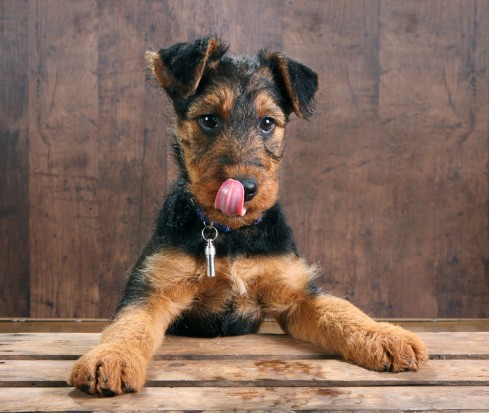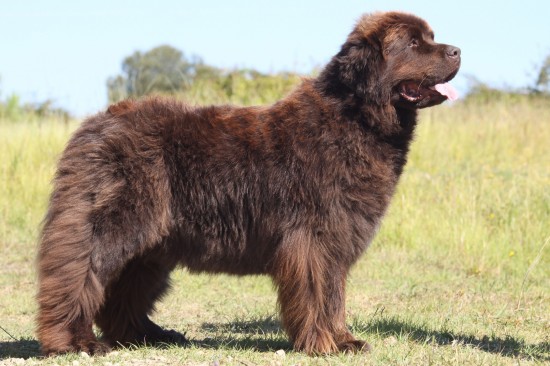
Separation anxiety problems are diagnosed in around 15% of all behavioural cases. When left alone, most dogs will find a familiar spot and go to sleep. However, a dog when suffering from separation anxiety may become extremely anxious. Not understanding where you or your family have gone or if you will ever return, this dog may exhibit behaviour which can include chewing, barking, salivating, urinating, defecating, vomiting or escape behaviour such as chewing through walls, scratching through doors or exit points, breaking out of cages or trying to dig their way out of gardens and enclosures.
In some cases, the dog can become extremely ill, stop eating, or suffer from depression. I often find single dogs kept in kennels can become morose or lethargic. This can be a major problem with some of our working dogs who are often kennelled and therefore do suffer accordingly. I personally believe that if you intend to kennel your dog then you really should have more than one dog in that environment.
Dogs are conspecific that means that they can generally only form a true pack with their own kind, They do create a loose pack type alliance with us and are integrated into our family unit, however that normally does not happen when dogs are not allowed indoors and are restricted to a kennelled area. These dogs do need the companionship and company of other dogs when in this situation. If we were to look at it in human terms, it would be equivalent of solitary confinement.
Possible Causes
Factors at the root of Separation Anxiety can include, genetics, insufficient early learning and handling, lack of socialisation and owner behaviour, sometimes we reinforce an overbonding relationship that causes the dog stress when we are not around. This type of dog will follow you everywhere and that includes the toilet. We can often exacerbate the problem by making a big scene when we leave. Was it Shakespeare that wrote, “parting is such sweet sorrow, That I shall say good night till it be morrow”.?
Your dog is a social, pack animal that relies on others for individual protection, it finds safety in numbers, and will feel ostracised from the pack if not allowed to mix freely with its extended family, which includes humans and other dogs. In wolf packs, an individual that is forced to leave the pack will often die if it cannot join another pack. Often these dogs are males that have been usurped from the Alpha position or have challenged for top position and failed. Making it unlikely to be accepted into another pack and will be unable to hunt as effectively on its own.
Dogs retain vestigial wolf characteristics, is it therefore any wonder they feel anxious in when placed in these situations?
Dogs that lack confidence, due to over bonding, under socialisation, or lack of training in basic obedience, mistreatment in the past, long confinements or dogs that have been abandoned or placed in rescue centres are most likely to exhibit behaviours relating to separation anxiety.
Solution and Treatment
• No long goodbyes
When it is time to leave, just leave. Do not say a big and drawn out “Good bye” to your dog. In fact, ignore your dog for five minutes before you go. Paying too much attention will make your dog feel more insecure when that attention is abruptly withdrawn. You may wish to use a herbal type anxiety reducer such as Dr Bach’s rescue remedy, you can get this in any good chemist 4 drops a day in their food, and a DAP diffuser you can get this from your Vets. It plugs in the wall socket and gives out calming pheromones. DAP means Dog Appeasing Pheromone, the clever little scientists have isolated the pheromone that the nursing mother gives out to calm the little pups when she is feeding them, and have created a chemical mimic These combined can help to take the edge of the anxiety. Always discuss any herbal or natural remedies or treatment with your Vet.
• Distractions are the key
Prepare a “Good-Bye” bone. These are hollow cheese or meat filled bones purchased from the pet shop, or it could be a Kong. When it is empty, fill it with grated cheese, peanut butter, or other things your dog really likes. You can even make up a thick soup type mixture, fill the hollow bones with these and freeze, put it away and only take it out when you leave each day. Place it near your dog just before you close the door. When you arrive back home put the bone away. The bone only comes out when you leave. when it gets low then poke out the contents and refill.
You are distracting your dog with something that he will find interesting enough to concentrate on and will ignore your leaving, he should appreciate the bone so much that he will look forward to it coming out instead of getting upset with your leaving. You can also get puzzle type activity cubes or balls these are meant to be filled with dried kibble or treats, the dog has to manipulate these to get bits of treat out .Some are quite difficult to use giving the dog lots to work at rather than thinking about your departure. Once again, only give this to your dog when you are leaving and take away when you return.
• Crate Train
Confining your dog during your times of absence has two positive results. First, a dog who is confined crate cannot do damage to your home. Secondly, a crate, when properly introduced, will act as a safe and comfortable den where the dog can relax. Limiting his movement also acts as an anxiety reducer for most dogs. However, dogs should not be locked in crates for long periods maximum during the day should be 2/3 hours and certainly only on rare occasions not every day.
• Exercise Your Dog
A dog that is lacking exercise is more likely to have stress and tension. Tiring a dog out with a long walk, run or with play goes a long way in reducing stress and anxiety.
• Leave the Radio On
Tune a radio to a talk station; not music, put it on in a room you are often in but not in the same room as the dog, and close the door. I use LBC 97.3 as the preferred station though of course not everyone can receive this. The dog will hear the human voices from another room and may not feel so alone. Some owners tape record their own voices and play the recording rather than the radio program. Dogs know the sound of your voice. This need only be a couple of hours long.
• Build up a routine
The hardest time for dogs is immediately after you leave. Their anxious, frantic, and occasionally destructive behaviour generally happens inside the first hour. You need to modify your dog’s behaviour through reinforcement training and behavioural modification. Leave your dog either in or out of the crate; get ready to leave, put your coat on or whatever routine you have when you leave, walk out as normal, come back after one minute greet your dog calmly tell him to sit, when he does, reinforce the behaviour with a food treat he enjoys.
Wait a few minutes and then repeat the exercise, this time remaining outside a few minutes longer. Continue practicing leaving and returning over the next couple of weeks, This has the effect of desensitising you dog to your exits and it will not know the length of the separation.
• Leadership is Vital
When a dog has a strong consistent leader, it has a calming effect on him. He feels safe and taken care of. In the absence of a strong leader, your dog feels obligated to assume that position in the social hierarchy of the family pack. Since a leader must control all that goes on, his inability to control you leaving causes him stress and anxiety. They sometimes exhibit dominant behaviour to try to stop owners from leaving. Obedience training and * NILIF techniques is normally the best methods of establishing yourself as a beneficial and strong leader.
Consistency is the key. You are responsible for providing food and shelter. You also have the responsibility of supplying an environment whereby the dog feels safe and secure. Leadership plays a part. lack of consistency and over-bonding can be a cause and effect of separation anxiety, though it must be said other factors may also play their part. Sometimes you may need to get another dog for company and comfort for you existing pet, especially if the symptoms are severe. Sometimes you may have to rehome the dog, as your lifestyle does not allow for a happy and contented pet and in both your best interests, this should be considered.
The NILIF technique mentioned here will be in a future article called “The Pushy Dog”
Stan Rawlinson
Stan Rawlinson
Dog Behaviourist and Obedience Trainer, who has owned and worked dogs for over 25 years, starting with gundogs then moving to the behavioural and obedience side of training companion dogs. He now has a successful practice covering
Greater London, Surrey, and Middlesex.
Stan is recommended by numerous Vets, Rescue Centres, and Charities. He writes articles and comments on behavioural issues and techniques for dog magazines including Our Dogs, Dogs Monthly and K9 Magazine and Shooting Times.
He is also the founder member of PAACT The Professional Association of Applied Canine Trainers
 Tortoise And Turtle Shells, And Potential Problems
Tortoise And Turt
Tortoise And Turtle Shells, And Potential Problems
Tortoise And Turt
 Ten Tips For Dealing With A Begging Dog
Ten Tips For Deal
Ten Tips For Dealing With A Begging Dog
Ten Tips For Deal
 The Large And Lovely Newfoundland Dog
The Large And Lov
The Large And Lovely Newfoundland Dog
The Large And Lov
 Toxoplasma In Cats, Why It Is Important
Toxoplasma in Cats is pretty common and here I will exp
Toxoplasma In Cats, Why It Is Important
Toxoplasma in Cats is pretty common and here I will exp
 An Exercise In Exercise Patient: Why The Dog Is Banned From Future Workouts
Although the dog is just a bit overweight, she is no lon
An Exercise In Exercise Patient: Why The Dog Is Banned From Future Workouts
Although the dog is just a bit overweight, she is no lon
Copyright © 2005-2016 Pet Information All Rights Reserved
Contact us: www162date@outlook.com